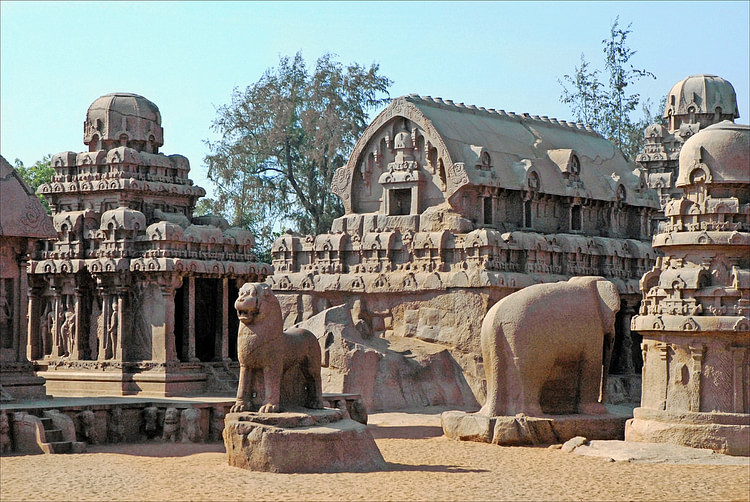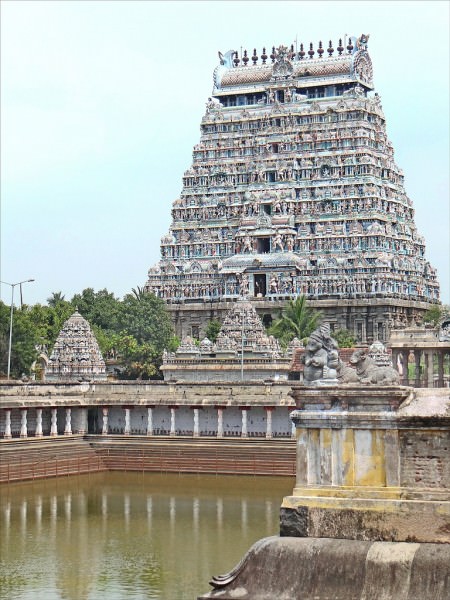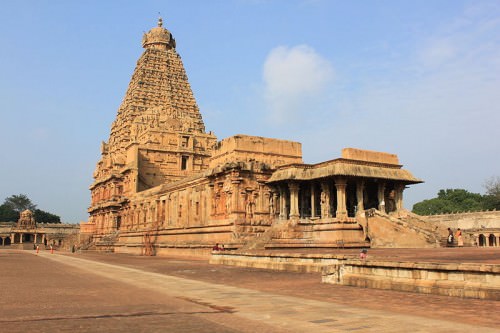Mahabalipuram › Hindu Architecture » Ancient origins
Articles and Definitions › Contents
- Mahabalipuram › Ancient History
- Hindu Architecture › Antique Origins
Ancient civilizations › Historical and archaeological sites
Mahabalipuram › Ancient History
Definition and Origins

Mahabalipuram or Mamallapuram is a historic city and UNESCO World Heritage site in Tamil Nadu, India. During the reign of the Pallava dynasty, between the 3rd century CE and 7th century CE, it became an important centre of art, architecture and literature. Mahabalipuram was already a thriving sea port on the Bay of Bengal before this time. A significant amount of coins and other artefacts excavated from this region also indicate a pre-existing trade relation with the Romans even before it became a part of the Pallava Empire.
EARLY HISTORY
Mahabalipuram's early history is completely shrouded in mystery. Ancient mariners considered this place the land of the Seven Pagodas. There are others who think that Mahabalipuram suffered from a great flood between 10,000 and 13,000 BCE.Controversial historian Graham Hancock was one of the core members of a team of divers from Indian National Institute of Oceanography and the Scientific Exploration Society based in Dorset, UK who surveyed the ocean bed near Mahabalipuram in 2002 CE. He is more inclined to believe the flood theory. His exploration also afforded him a fair glimpse of the vast extent of submerged ruins of the city. After his underwater exploration, he reportedly commented, “I have argued for many years that the world's flood myths deserve to be taken seriously, a view that most Western academics reject … But here in Mahabalipuram, we have proved the myths right and the academics wrong.”
Many opinions exist about the origin of the name of the site too. The most popular explanation is that the place is named after benevolent King Bali, also known as Mahabali. The ancient Indian text of Vishnu Puran documents his exploits. After sacrificing himself to Vaman, an incarnation of Vishnu, he attained liberation. “Puram” is a Sanskrit term for a city or urban dwelling. Mamallapuram is the Prakrit version of the original Sanskrit name.
DURING THE RULE OF MAHENDRAVARMAN I (600 CE – 630 CE), MAHABLIPURAM STARTED TO FLOURISH AS A CENTRE OF ART AND CULTURE.
During the rule of Mahendravarman I (600 CE – 630 CE), Mahablipuram started to flourish as a centre of art and culture. He himself was a well known poet, playwright and orator. His patronage helped the creation of a number of the city's most iconic landmarks. This period of artistic excellence was duly continued by his son Narasimhavarman I (630 CE – 680 CE) and subsequent Pallava kings.
ART & ARCHITECTURAL MASTERPIECES
Cave Temples
The Adi Varaha Perumal Cave Temple is the earliest of all Pallava structures in Mahabalipuram, yet the least visited one. The grandeur of the actual mandapa (pavilion) is hidden behind a rather ordinary looking latter-day structure. The construction of this site began before the reign of Mahendravarman I. The temple is dedicated to Vishnu (Varaha is an incarnation of Vishnu) and its execution follows the spirit of Vaishnava Agamic texts. Both the outer hall and sanctum sanatorium are adorned with elaborate relief sculptures. This temple houses two relief sculptures of Pallava kings, Simhavishnu (c. 537 CE – 570 CE) and Mahendravarman I, accompanied by their respective wives.
The Trimurti Cave is dedicated to the trinity of Brahma, Vishnu and Maheswara ( Shiva ) representing the process of creation, sustenance and destruction. Aside from the deity, the carved pillars and sculptures also show devotees in various postures. The Varaha and Krishna Caves exhibit mythical tales related to Vishnu and Krishna.
The Mahishasuramardini Cave can be found at a hilltop location. Mahishasuramardini is another name of the goddess Durga who is an incarnation of Shakti (power). She earned this name after the slaying of the demon Mahishasura. This is the second, along with the Kotikal Cave, of the caves dedicated to Durga.
Technically speaking, the Yali or Tiger Cave may not be a geographic fissure, but it boasts a set of most elaborately designed pillars and sculptures depicting several mythical creatures, lions and tigers. This also has a relief sculpture dedicated to Narasimhavarman II or Rajasimha (700 CE – 728 CE). In many ways, the Tiger Cave sums up the evolution of the Pallava's cave temple structures over a period of time.

Descent of the Ganges
Descent of the Ganges
Alternatively known as Arjuna ’s Penance, Descent of the Ganges is a gigantic open air bas-relief sculpted out of pink granite.The dramatic relief sculpture narrates the tales from Indian epics such as the Mahabharata. Nearby mandapa s, particularly the Krishna Mandapa, however, showcase scenes of pastoral life amid mythical figures. Other similar rock artworks close by have been left unfinished due to some unexplained reason.
Pancha Ratha
Pancha Ratha (five chariots) is an architectural ode to Mahabharata ’s five Pandava brothers Yudhistir, Bhima, Arjuna, Nakula, Sahadeva, and their wife Draupadi. Thematically and structurally, each ratha is significantly different from the other ones, but all of them were carved out of a long stone or monolith. Spread over one to three storeys, their forms vary from square to apsidal. The walls of these ancient edifices are decorated with bas-reliefs and murals. A beautifully carved monolithic airavata(elephant) and nandi (bull) decorate the premises. Though originally meant to be places of worships, these were never consecrated and used actively for any sacred rites.
Shore Temple
The Shore Temple is located on the beach and if local lore is to be trusted it is the one surviving structure of the legendary Seven Pagodas. Despite continuous erosive effects of the moist and salty sea air, the Shore Temple preserves its beauty in many parts. Built between 700 and 728 CE during the reign of Narasimhavarman II, this is indeed a remnant of a larger complex of temples and civil structures much of which lie under the depth of the sea now.

Shore Temple, Mahabalipuram
This five story edifice is so situated that the first rays of the rising sun fall on the presiding deity of the temple, Shiva. Visitors enter the premises through a barrel vaulted gopuram (gateway). The shikhara (roof) of the actual shrine resembles a pyramidal structure. Like other remarkable structures at Mahabalipuram, this too is embellished with intricate bas-reliefs.Monolithic sculptures are also seen scattered about the temple complex.
Olakkanneshvara Temple
Also known as the Olakkanatha Temple, the Olakkanneshvara Temple (Temple of Shiva, suggestive of the third eye of Shiva) was built about the same time as the Shore Temple. This is located atop a hill some distance away from the beach which gave birth to a belief that it acted as a lighthouse in earlier times. This is also built atop the Mahishasuramardini Cave, but the two are different structures erected at different times.
MAHABALIPURAM TODAY
There is another curious structure known as Sri Krishna's Butter Ball that fascinates everyone in Mahabalipuram. It is not a sculpted piece but more of a handiwork of nature. Today, Mahabalipuram is trying to re-create its image as the country's premier beach resort but it has not completely lost touch with its past cultural exploits. Every year, it hosts classical dance and drama festivals to preserve and promote the heritage of a very ancient culture.
Ironically, while the tsunami in 2004 CE created substantial damage to the existing structures and left the city water-logged for days, it also unearthed some of the treasures long hidden in the bosom of the sea. Granite sculptures, bronze statues and ruins of what seem to be manmade structures came to the fore. Underwater archaeologist Dr Alok Tripathi commented, “As the tsunami waves receded, they scoured away sand deposits that had covered these sculptures for centuries.” The underwater survey of Mahabalipuram is an ongoing process that promises to reveal many more of the city's grand edifices and solve some of the long standing questions about its past.
MAP
Hindu Architecture › Antique Origins
Definition and Origins

Hindu architecture evolved over the centuries from simple rock-cut cave shrines to massive and ornate temples which spread across the Indian sub-continent and beyond, forming a canonical style which is still adhered to today in modern Hindu temples across the globe. Essential elements of the style are precise and harmonious geometry when viewed from all four sides and above, the square form and grid ground plans, soaring towers, and elaborate decorate sculpture which includes gods, worshippers, erotic scenes, animals, and floral and geometric patterns.
BEGINNINGS & PURPOSE
From the 1st century CE a new type of worship known as Bhakti or devotional Hinduism spread across the Indian sub-continent, and the old Vedic gods were replaced in importance by deities like Shiva, Vishnu, Krishna, Brahma, and Devi.These gods would become the central figures of Hinduism and their worship required temples where the devoted could offer their thanks and reveal their hopes for a better life.
Buildings were constructed which could house a sacred symbol of a particular god, which could be decorated with sculptural figures of them so recalling episodes from their mythological adventures, and which provided a space for worshippers to leave offerings and perform rituals such as bathing and dancing by professional female dancers ( devadasi ). The temple was considered the dwelling place of a particular god ( devalaya ). It was, therefore, a sacred place ( tirtha ) where heaven and earth meet and, as a god's home, it must be a suitably splendid palace ( prasada ). The needs of the god would, additionally, be supervised by a dedicated body of priests ( pujaris ) who attended the temple.
TEMPLES WERE BUILT TO HOUSE A SACRED SYMBOL OF A PARTICULAR GOD AND WERE DECORATED WITH SCULPTURAL FIGURES RECALLING EPISODES FROM MYTHOLOGY.
Hindus need not attend regular services, but an occasional walk around the temple interior (circumambulation), known as pradaksina and done in a clockwise direction, was considered auspicious. Further, they could say prayers, look at the god's representation – a specific act of piety known as darsan – and leave offerings of food and flowers ( puja ). Temples, inevitably, became the very centre of a community and, accordingly, their upkeep was guaranteed by land grants and endowments from the ruling class, as indicated by inscriptions on many temples.
EARLY INFLUENCES
Influenced by early Buddhist structures such as the stupa, the first Hindu temples were built from rock-cut caves and repeated the idea of relief panels and the decorative gavaska window form. Then, with the arrival of Gupta architecture in the 4th to 5th century CE, the first free-standing Hindu temples were constructed with features such as towers and projecting niches.
The first materials used were wood and terracotta, but architects gradually moved on to brick and stone, especially sandstone, granite, schist, and marble. No mortar was used in the older temples and so precise cutting of dressed stones was required.Outstanding examples of influential cave temples include those at Udaigiri in Malwa and date to the 5th century CE. Early free-standing temples survive at Deogarh and include the 6th century CE Dasavatara temple dedicated to Vishnu.

Durga Temple, Aihole
HINDU TEMPLE FEATURES
The Hindu temple ( mandir ) is laid out according to the eight cardinal directions, and a god representing each one ( dikpala ) may sometimes be represented in sculpture on the temple's exterior. Built on an elaborately carved platform ( adhisthana ), the temple is often referred to in ancient Hindu texts on architecture (the Vastu Shastras ) as the sacred mountain Meru or Kailasa, the dwelling of Shiva in the Himalayas. Indeed, seen from afar, and especially from above, many Hindu temples, with their multiple towers, appear very much like a mountain mass. The 11th century CE Kandariya Mahadeva temple at Khajuraho and 12th century CE Rajarani temple at Bhubaneswar are outstanding examples of this effect.
The most important part of a Hindu temple is the garbhagriha (translated as 'womb-chamber'), which is a small window-less shrine room located at the very heart of the temple. Within, a symbol or representation of a specific god was placed, for example, the linga (phallus) for Shiva. Worshippers consider that energy flows out in all directions from the garbhagriha, and this is reflected in the architecture of the surrounding parts of the temple. For example, on three sides temples have blind doors which symbolically allow the deity's energy to leave the inner garbhagriha. These portals ( ghana dvara ) may also act as secondary niche shrines for the deity too.

Gopura & Nataraja Temple, Chidambaram
Early temples consisted of only a garbhagriha, but over time additions were built and copied across temple sites to create, by the 10th century CE, a canonical architectural style. The most obvious of these features were a portico entrance ( ardhamandapa ) and pillared hall ( mandapa ) which led to the garbhagriha – features which developed in the Deccan from the 8th century CE. Even more impressive, above the garbhagriha a huge corbelled tower was constructed, the sikhara. One of the earliest examples incorporating these features can be found in Aiholi and the 8th century Durga temple, whilst one of the most ornate is the 12th century CE Nataraja Temple at Chidambaram in the Tamil Nadu.
NAGARA & DRAVIDA TEMPLES
Architecture evolved slightly differently in different regions, such as the distinct features of Orissa, Kashmir and Bengal temples, but two general types are identified as the Nagara (North) and Dravida (South) styles. The sikhara tower in Nagara temples have a sloping curve as they rise, have decorative arches known as gavakshas, and are topped by an amalaka – a large fluted stone disk – and also a small pot and finial. The walls of Nagara temples present a complex exterior of projections (known as ratha and ultimately there would be seven on each side) which create many recesses. In contrast, Dravida towers (known separately as vimana ) are more dome-like with cornices, and they are topped by another smaller dome. The exterior walls of Dravida temples have regular entablatures which often contain sculpture. Southern Indian temples can also have a ritual bathing tank or pool ( nandi mandapa ), may have a barrel-vaulted ( shala ) roof, and are typically enclosed within a walled courtyard with a gate ( gopura ) which over time would become even more massive and ornate than the temple itself.The 11th century CE Brihadishvara Temple complex at Tanjavur is a wonderful example which incorporates all of these features.

Brihadishvara Temple, Tanjavur
CONCLUSION
Beginning with humble caves and squat flat-roofed temples, Hindu architecture, then, evolved over the centuries and, despite some regional variation, arrived at a standard arrangement which involved a huge walled complex with massive decorative gateways giving entrance to a sacred space of lesser shrines dominated by the main temple and its monumental series of towers. The design has become so standard that it is copied even today in temples across the world from New Delhi to Malibu, California.
LICENSE:
Article based on information obtained from these sources:with permission from the Website Ancient History Encyclopedia
Content is available under License Creative Commons: Attribution-NonCommercial-ShareAlike 3.0 Unported. CC-BY-NC-SA License